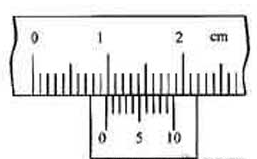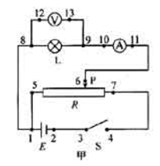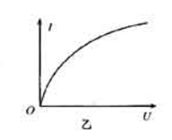(1)某实验小组在利用单摆测定当地重力加速度的试验中:
①用游标卡尺测定摆球的直径,测量结果如图所示,则该摆球的直径为 cm。

②小组成员在试验过程中有如下说法,其中正确的是 。(填选项前的字母)
A.把单摆从平衡位置拉开30度的摆角,并在释放摆球的同时开始计时
B.测量摆球通过最低点100次的时间t,则单摆周期为
C.用悬线的长度加摆球的直径作为摆长,代入单摆周期公式计算得到的重力加速度值偏大
D.选择密度较小的摆球,测得的重力加速度值误差较小
(2)某同学在探究规格为“6V,3W”的小电珠伏安特性曲线实验中:
①在小电珠介入电路前,使用多用电表直接测量小电珠的电阻,则应将选择开关旋至_______档进行测量。(填选项前的字母)
A.直流电压10V B.直流电流5Ma
C.欧姆× 100 D.欧姆× 1
②该同学采用图甲所示的电路进行测量。图中R为华东变阻器(阻值范围0~20 ,额定电流1.0A),L为待测小电珠,V为电压表(量程6V,内阻20k
,额定电流1.0A),L为待测小电珠,V为电压表(量程6V,内阻20k ),A为电流表(量程0.6A,内阻1
),A为电流表(量程0.6A,内阻1 ),E为电源(电动势8V,内阻不计),S为开关。
),E为电源(电动势8V,内阻不计),S为开关。

Ⅰ.在实验过程中,开关S闭合前,华东变阻器的画片P应置于最________端;(填“左”或“右”)
Ⅱ.在实验过程中,已知各元器件均无故障,但闭和开关S后,无论如何调节滑片P,电压表和电流表的示数总是调不到零,其原因是______点至________点的导线没有连接好;(图甲中的黑色小圆点表示接线点,并用数字标记,空格中请填写图甲中的数字,如“2点至3点”的导线)
Ⅲ.该同学描绘出小电珠的伏安特性曲线示意图如图乙所示,则小电珠的电阻值随工作电压的增大而____________。(填“不变”、“增大”或“减小”)


(1)①游标卡尺读数为:9mm+7×0.1mm=9.7mm=0.97cm
②把单摆从平衡位置拉开10度的摆角,在最低点开始计时,A错误
测量摆球通过最低点100次的时间t,则单摆周期为 ,B错误
,B错误
用悬线的长度加摆球的直径作为摆长(摆长偏大),因为 ,所以代入单摆周期公式计算得到的重力加速度值偏大,C正确
,所以代入单摆周期公式计算得到的重力加速度值偏大,C正确
选择密度较小的摆球,测得的重力加速度值误差较大,D错误
故选C
(2)Ⅰ.在实验过程中,开关S闭合前,华东变阻器的画片P应置于最左端,使得分压部分电压为零
Ⅱ.电压表和电流表的示数总是调不到零,其原因是滑动变阻器起不到分压作用,可能是连成限流电路了,即1点至5点的导线没有连接好;
Ⅲ.伏安特性曲线的斜率表示电阻的倒数,跟据图像可知小电珠的电阻值随工作电压的增大而增大
